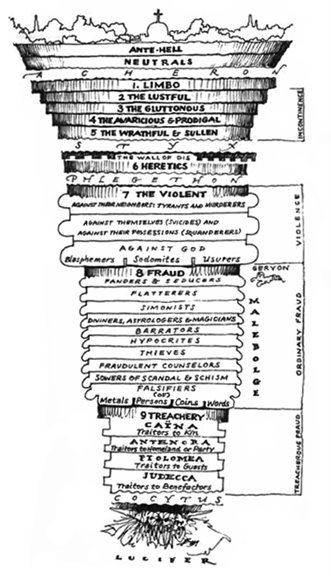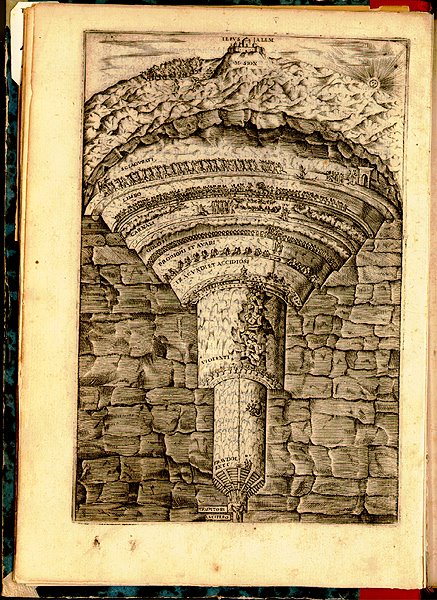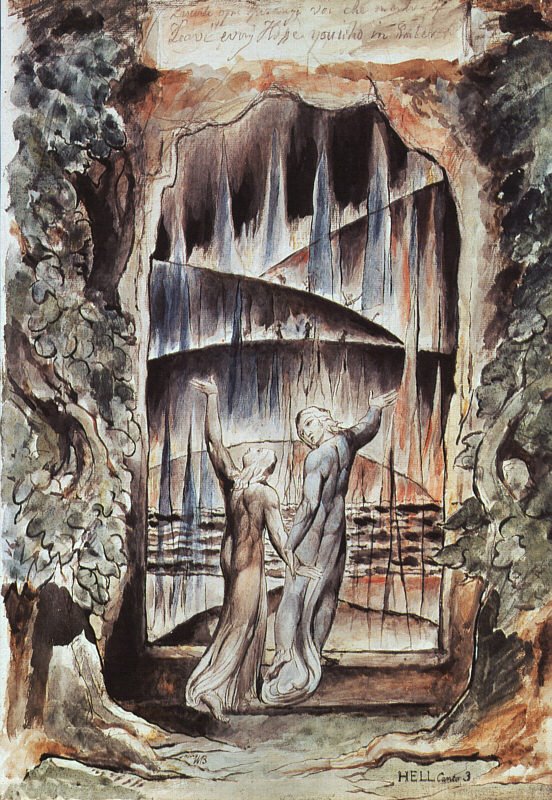 [Image: From Drawings for Dante’s Inferno by Rico Lebrun, via Annex Galleries].
[Image: From Drawings for Dante’s Inferno by Rico Lebrun, via Annex Galleries].
Artist Rico Lebrun once remarked that he was interested in “changing what is disfigured into what is transfigured,” aiming to depict “mineral and spiritual splendor.”
 [Image: “Figures in Black & White” (ca. 1961) by Rico Lebrun, via Mutual Art].
[Image: “Figures in Black & White” (ca. 1961) by Rico Lebrun, via Mutual Art].
Originally from Naples, Italy, where he painted murals, Lebrun brought a macabre sense of body horror to classic myths and religious illustrations. Think of him as a kind of Italian-American version of Francis Bacon.
Lebrun has been described as “one of the most unjustly neglected artists of the postwar era… Lebrun’s last major exhibition was in 1967 and it was hastily thrown together. He has never had [a] critically curated retrospective that locates his art in its time and place, and neither has he had a scholarly monograph to take the measure of his career.”
 [Image: From Drawings for Dante’s Inferno by Rico Lebrun, this is “Canto XXV—Circle Eight: Bolgia of the Thieves; their penance was to be changed from humans into snakes.” Via University of Wisconsin-Milwaukee].
[Image: From Drawings for Dante’s Inferno by Rico Lebrun, this is “Canto XXV—Circle Eight: Bolgia of the Thieves; their penance was to be changed from humans into snakes.” Via University of Wisconsin-Milwaukee].
What I find so interesting in Lebrun’s work is how sculptural and bloated anatomical forms become worlds unto themselves, divorced from their contexts. They are humid, planetary, often trapped in monstrous pregnancies or what could pass for ritualized medical events. Lebrun depicts Hell as a place of limitless metastasis and uncontrolled mutation.
 [Image: Rico Lebrun, “Untitled” (1956), via Artnet].
[Image: Rico Lebrun, “Untitled” (1956), via Artnet].
In other images, broken skeletons seem to emerge from the wrong skin, people lump over one another as if grafted together in molten surgery, and limbs are splayed wide, almost pornographically, in tumbled piles of flesh.
 [Image: From Drawings for Dante’s Inferno by Rico Lebrun].
[Image: From Drawings for Dante’s Inferno by Rico Lebrun].
His most notable projects—including illustrations for Dante’s Divine Comedy, scenes of the Crucifixion, and a project focused on the Holocaust—all explored grotesque exaggerations of the human form, seeming to fuse multiple figures into one, even hybridizing animal bodies with the isolated suffering of people broken and betrayed by the world around them.
 [Image: From Rico Lebrun, Paintings and Drawings of the Crucifixion].
[Image: From Rico Lebrun, Paintings and Drawings of the Crucifixion].
Serpents wrap around and consume doomed humans; writhing bodies seem frozen into stone atop tombs.
“Some are bloody,” he wrote in a letter to a friend, describing his drawings for Dante’s Inferno, “and horrifying as the cantos in the Inferno are; there is no other way to depict terror as Dante describes it, without turning the whole thing into an assembly of sedately arranged figures having a picnic in a dark place…”
 [Images: From Drawings for Dante’s Inferno by Rico Lebrun].
[Images: From Drawings for Dante’s Inferno by Rico Lebrun].
According to translator John Ciardi, “it is only Rico Lebrun who succeeds in giving me a graphic Inferno… Hell is not a Gothic cave, nor is it a festival of dance rhythms, nor is it a series of monkish miniatures. It is a concept.”
Lebrun died in 1964.
 [Image: Dante’s great cyclotron of souls in the
[Image: Dante’s great cyclotron of souls in the  [Image: After Hell, stars; from Dante’s
[Image: After Hell, stars; from Dante’s  [Image: Dante’s Inferno, as imagined by
[Image: Dante’s Inferno, as imagined by 

 —complete with interesting subsurface faults and fractured bedrock, in section. One could easily imagine an obscure branch of the Renaissance academy in Rome publishing tract after tract on the exact geotechnical nature of the Inferno. Is it made of granite? Is it kiln-like? Is it slate? Is it ringed by rivers of
—complete with interesting subsurface faults and fractured bedrock, in section. One could easily imagine an obscure branch of the Renaissance academy in Rome publishing tract after tract on the exact geotechnical nature of the Inferno. Is it made of granite? Is it kiln-like? Is it slate? Is it ringed by rivers of  And, finally, making no attempt at all to sustain the visual thread, there’s William Blake–
And, finally, making no attempt at all to sustain the visual thread, there’s William Blake– —a perennial favorite of mine, which shows us Dante and Virgil both, walking hand-in-hand through a shimmering geomagnetic curtain, a
—a perennial favorite of mine, which shows us Dante and Virgil both, walking hand-in-hand through a shimmering geomagnetic curtain, a